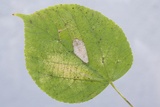Phyllonorycter issikii (Kumata, 1963) Species
Last modified: Dec. 10, 2025, 5:09 p.m.
A very rare species in Belgium, thus far (2020) only known from the northeastern part of the country. Contrary to e.g. Cameraria ohridella, another invasive gracillariid species, Ph. issikii does not spread fast over the rest of the country, though its larval hostplant is readily available almost everywhere.
Details
- Classification
- Family: Gracillariidae > Subfamily: Lithocolletinae > Genus: Phyllonorycter > Species: Phyllonorycter issikii
- Vernacular names
- Lindevouwmot (NL), Linden midget (EN), Lindenminiermotte (DE)
- First mention in Belgium
- Wullaert S. 2012b. Phyllonorycter issikii (Lepidoptera: Gracillariidae), new to the Belgian fauna. — Phegea 40(3): 63–65. On page 63. view page
- Status
-
Invasive In Belgium since October 2011.
Discovered as mines on Tilia cordata at Zutendaal (LI), leg. S. Wullaert. Established in the northeastern part of Belgium but thus far (2020) absent elsewhere. The species originates from Japan and some other countries in the East Palaearctic. It was probably introduced into eastern Europe in 1970 and from there it spread gradually towards the west.
Distribution
Imago
Dimorphic species; the summer generation has a brownish ground color while the autumn generation is much more greyish, sometimes even dark grey. Like in many other Phyllonorycter species the whitish pattern is present, but rather indistinct, especially in the greyish form.
Museum specimens
No pictures yet!Specimens in nature
No pictures yet!Caterpillar
Not unicolorous as most Phyllonorycter larvae but partly yellowish and partly whitish.
Mine
Rather flat tentiform mine at the underside of a leaf. Sometimes more mines are on one leaf, and in such cases, the leaf is more contorted. Full-developed mines are easily seen from the upperside as light greyish patches. Frass is concentrated in a corner of the mine and seen as black patches inside the mine.
See also gracillariidae.net and bladmineerders.be.
Cocoon/pupa
Dark brown pupa.
Bionomics
The species has a preference for the lower branches of Tilia trees of which the leaves are more in the shadow. Hibernation in the cocoon of the second generation among leaf litter on the ground. It has been observed, however, that from collected mines in October, some adults emerge, indicating that the species might, at least partially, hibernate in the adult stage as well.
Flight periods
The adults fly in two generations a year during May and August.
Observed on
- Host plant (species):
- Tilia cordata and Tilia platyphyllos
The species has a preference for Tilia cordata, but it has been recorded from other Tilia species as well, like Tilia platyphyllos.




